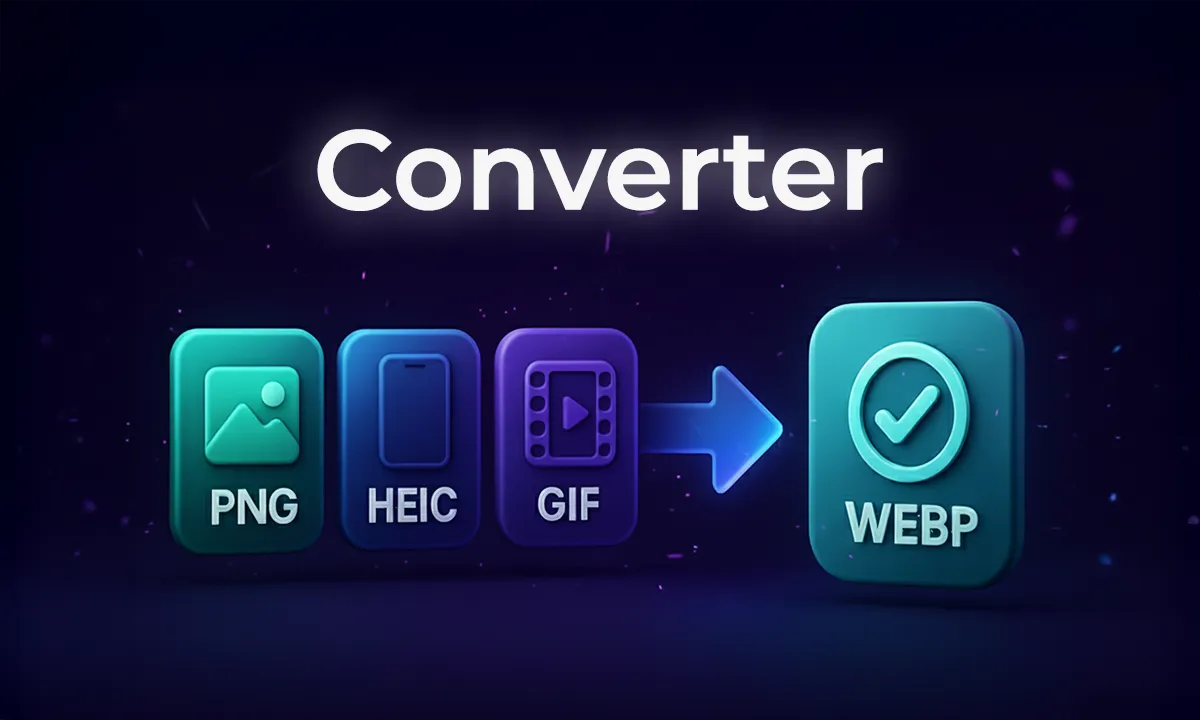WebP 변환기 – JPG, PNG부터 HEIC, AVIF까지 모든 포맷 지원

궁금한 점이 있으신가요?
FAQ에서 바로 확인하세요.
‘간편 변환’이 아닌, ‘전문가급 최적화 변환’을 제공하기 때문입니다.
대부분의 무료 도구들은 사용자의 웹브라우저 성능에 의존하는 ‘간편 변환(Client-side Converting)’ 방식을 사용합니다.
이 방식은 속도는 빠르지만, 이미지의 디테일한 설정(압축률, 색상 프로파일 등)을 정밀하게 제어하기 어렵습니다.
비볼디는 업로드된 이미지를 고성능 서버로 전송하여, 자체 개발한 ‘비볼디 스마트 이미징 엔진(Vivoldi Smart Imaging Engine)’으로 분석하고 재가공합니다.
단순히 포맷만 바꾸는 것이 아니라 화질, 용량, 호환성까지 고려한 ‘완전한 재설계(Re-mastering)’ 과정을 거치기 때문에 고품질 결과물을 보장합니다.
네, 서버의 ‘독립 병렬 처리’ 기술로 모든 파일에 균일한 고화질을 제공합니다.
사용자의 PC 성능을 나눠 쓰는 일반적인 도구는 파일이 많아지면 처리가 지연되거나 일부 파일의 변환이 실패할 수 있습니다.
비볼디는 대용량 트래픽 처리에 최적화된 ‘병렬 처리 아키텍처’를 적용하여, 100장의 이미지를 동시에 변환하더라도 각각의 파일에 독립된 서버 자원을 할당합니다.
덕분에 수량에 관계없이 항상 일관된 최상의 품질과 속도를 경험하실 수 있습니다.
WebP는 Google이 개발한 차세대 이미지 포맷으로, 웹사이트와 앱에서 이미지를 더 빠르게 로딩하고 저장 공간을 절약하기 위해 설계되었습니다.
JPG, PNG와 같은 기존 이미지 형식보다 최대 80% 작은 용량으로 저장할 수 있으면서도, 화질은 거의 손실 없이 유지됩니다.
특히 웹사이트에 업로드되는 이미지 용량이 줄어들면 페이지 로딩 속도 개선, SEO 순위 향상, 방문자 이탈률 감소에 직접적인 효과가 있습니다.
이는 온라인 쇼핑몰, 블로그, 뉴스 사이트 등 이미지 중심의 웹 서비스에서 매우 큰 장점이 됩니다.
또한 WebP는 정적인 사진뿐 아니라 투명 배경(알파 채널)과 애니메이션까지 지원합니다.
Google에 따르면 애니메이션 WebP는 GIF 대비 훨씬 작은 용량으로 고품질 이미지를 제공하므로, 웹 퍼포먼스 최적화에 최적의 대안입니다.
결론적으로, WebP 파일은 웹사이트 속도와 SEO 성능을 동시에 높여주는 최신 이미지 포맷으로, 앞으로의 웹 환경에서 필수적인 기술이라고 할 수 있습니다.
WebP 파일은 2010년 Google이 인수한 On2 Technologies에서 개발한 이미지 포맷으로, 같은 해 처음 공개되었습니다.
이 포맷은 VP8 및 VP8L 코덱을 기반으로 만들어졌으며, 기존 JPG·PNG보다 작은 용량과 높은 품질을 동시에 제공하는 것을 목표로 설계되었습니다.
2011년 Google은 WebP에 애니메이션과 투명도(알파 채널) 지원을 추가하면서 단순 정적 이미지 포맷을 넘어 GIF와 PNG까지 대체할 수 있는 강력한 형식으로 발전시켰습니다.
이후 꾸준한 업데이트를 통해 다양한 웹 표준에 맞게 진화해왔습니다.
현재 WebP는 Google Chrome, Firefox, Microsoft Edge, Opera, Safari 등 거의 모든 주요 브라우저에서 지원되며, WordPress·Shopify 같은 CMS 플랫폼과 대형 전자상거래 사이트에서도 널리 사용되고 있습니다.
많은 웹 개발자와 디자이너들은 WebP 변환기를 활용해 기존 PNG·JPEG·GIF를 WebP로 바꾸어 웹사이트 로딩 속도를 개선하고, SEO 성능과 사용자 경험을 동시에 강화하고 있습니다.
결론적으로, WebP는 2010년에 탄생해 지금은 글로벌 웹 표준으로 자리 잡은 이미지 포맷으로, 웹사이트 최적화와 성능 향상에 있어 필수적인 기술이라 할 수 있습니다.
WebP 이미지는 기존 JPG, PNG보다 용량을 크게 줄이면서도 화질은 유지할 수 있어, 웹사이트 최적화와 SEO 개선에 효과적인 최신 이미지 포맷입니다. 그렇다면 JPG나 PNG 이미지를 어떻게 WebP로 변환할 수 있을까요?
- 그래픽 편집 프로그램 활용: Adobe Photoshop, GIMP, Paint.NET, Photopea 등 대부분의 디자인 툴에서 이미지를 불러온 뒤 “다른 이름으로 저장” 기능을 통해 WebP 형식으로 저장할 수 있습니다.
Photoshop은 플러그인 또는 기본 기능으로 WebP 변환을 지원합니다. - 온라인 WebP 변환기 사용: 가장 간단한 방법은 비볼디 WebP 변환기 같은 무료 온라인 도구를 이용하는 것입니다.
JPG, PNG, GIF 이미지를 업로드하면 몇 초 만에 WebP 파일로 변환 및 다운로드가 가능하며, 추가 프로그램 설치가 필요 없습니다. - 품질 & 압축률 조정: WebP 변환 시 압축률과 화질을 직접 설정할 수 있어, 용량 절감과 고화질 유지 사이에서 최적의 균형을 선택할 수 있습니다.
WebP 이미지는 현재 Google Chrome, Microsoft Edge, Firefox, Safari, Opera 등 대부분의 최신 브라우저에서 완벽하게 지원됩니다.
또한 iOS와 Android 기반의 모바일 브라우저에서도 호환성이 뛰어나 웹사이트, 쇼핑몰, 블로그 어디에서든 빠른 로딩 속도와 최적화된 이미지를 제공합니다.
- 데스크톱 지원: 크롬, 엣지, 파이어폭스, 오페라, 사파리 최신 버전에서 기본 지원.
- 모바일 지원: iPhone, iPad, Android 기본 브라우저 및 대부분의 모바일 앱 내장 브라우저에서도 호환.
- 제한 사항: 일부 구형 브라우저(예: Internet Explorer)와 오래된 OS에서는 WebP를 지원하지 않을 수 있음.